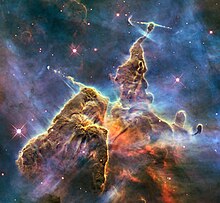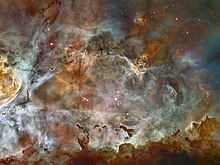Mystic Mountain: Difference between revisions
Punctuation, template & link corrections |
Apparently, this happened. - Reference edited with ProveIt |
||
| Line 4: | Line 4: | ||
[[File:Dark Clouds of the Carina Nebula.jpg|thumb|The location of the feature can be seen in this wider view of the Carina Nebula.]] |
[[File:Dark Clouds of the Carina Nebula.jpg|thumb|The location of the feature can be seen in this wider view of the Carina Nebula.]] |
||
'''''Mystic Mountain''''' is a photograph and a term for a region in the [[Carina Nebula]] imaged by the [[Hubble Space Telescope]]. The view was captured by the then-new [[Wide Field Camera 3]], though the region was also viewed by the previous generation instrument. The new view celebrated the telescope's 20th anniversary of being in space in 2010.<ref name="wapo20150416">{{cite web |url=https://www.washingtonpost.com/news/achenblog/wp/2015/04/16/mystic-mountain-is-this-the-hubble-space-telescopes-greatest-image/ |title=Mystic Mountain: Is this the Hubble Space Telescope's greatest image? |work=The Washington Post |first=Joel |last=Achenbach |date=16 April 2015 |access-date=24 November 2016}}</ref> Mystic Mountain contains multiple [[Herbig–Haro object]]s where [[star formation|nascent stars]] are firing off jets of gas which interact with surrounding clouds of gas and dust.<ref name="heritage20070424">{{cite web |url=http://heritage.stsci.edu/2007/16/supplemental.html |title=Interactive: The Carina Nebula in all its Glory... |work=The Hubble Heritage Project |date=24 April 2007 |access-date=24 November 2016}}</ref><ref name="hubsite20100422">{{cite web |url=http://hubblesite.org/newscenter/archive/releases/2010/13/image/a/ |title=Starry-Eyed Hubble Celebrates 20 Years of Awe and Discovery |website=Hubblesite.org |date=22 April 2010 |access-date=24 November 2016}}</ref> |
'''''Mystic Mountain''''' is a photograph and a term for a region in the [[Carina Nebula]] imaged by the [[Hubble Space Telescope]]. The view was captured by the then-new [[Wide Field Camera 3]], though the region was also viewed by the previous generation instrument. The new view celebrated the telescope's 20th anniversary of being in space in 2010.<ref name="wapo20150416">{{cite web |url=https://www.washingtonpost.com/news/achenblog/wp/2015/04/16/mystic-mountain-is-this-the-hubble-space-telescopes-greatest-image/ |title=Mystic Mountain: Is this the Hubble Space Telescope's greatest image? |work=The Washington Post |first=Joel |last=Achenbach |date=16 April 2015 |access-date=24 November 2016}}</ref> Mystic Mountain contains multiple [[Herbig–Haro object]]s where [[star formation|nascent stars]] are firing off jets of gas which interact with surrounding clouds of gas and dust.<ref name="heritage20070424">{{cite web |url=http://heritage.stsci.edu/2007/16/supplemental.html |title=Interactive: The Carina Nebula in all its Glory... |work=The Hubble Heritage Project |date=24 April 2007 |access-date=24 November 2016}}</ref><ref name="hubsite20100422">{{cite web |url=http://hubblesite.org/newscenter/archive/releases/2010/13/image/a/ |title=Starry-Eyed Hubble Celebrates 20 Years of Awe and Discovery |website=Hubblesite.org |date=22 April 2010 |access-date=24 November 2016}}</ref> This region is about {{convert|7500|ly|pc|lk=on|abbr=off}} away from Earth. The pillar measures around {{convert|3|ly|AU|lk=out|spell=in|abbr=off|disp=x| in height (|)}}.<ref name="wapo20150416"/> The name was influenced by the works of [[H. P. Lovecraft]].<ref>{{Cite book |last=Sheehan |first=William |title=Galactic Encounters: Our Majestic and Evolving Star-System, From the Big Bang to Time’s End |last2=Conselice |first2=Christopher J. |date=2015 |publisher=Springer |isbn=978-0-387-85347-5 |location=New York |page=166 |language=en |chapter=What Stuff Stars Are Made Of |doi=10.1007/978-0-387-85347-5_8}}</ref> |
||
This region is about {{convert|7500|ly|pc|lk=on|abbr=off}} away from Earth. The pillar measures around {{convert|3|ly|AU|lk=out|spell=in|abbr=off|disp=x| in height (|)}}.<ref name="wapo20150416"/> |
|||
==See also== |
==See also== |
||
Revision as of 05:57, 14 November 2021


Mystic Mountain is a photograph and a term for a region in the Carina Nebula imaged by the Hubble Space Telescope. The view was captured by the then-new Wide Field Camera 3, though the region was also viewed by the previous generation instrument. The new view celebrated the telescope's 20th anniversary of being in space in 2010.[1] Mystic Mountain contains multiple Herbig–Haro objects where nascent stars are firing off jets of gas which interact with surrounding clouds of gas and dust.[2][3] This region is about 7,500 light-years (2,300 parsecs) away from Earth. The pillar measures around three light-years in height (190,000 astronomical units).[1] The name was influenced by the works of H. P. Lovecraft.[4]
See also
- Pillars of Creation, another noted Hubble image
- List of deep fields
- HD 93129
- Trumpler 14
- List of Hubble anniversary images
References
- ^ a b Achenbach, Joel (16 April 2015). "Mystic Mountain: Is this the Hubble Space Telescope's greatest image?". The Washington Post. Retrieved 24 November 2016.
- ^ "Interactive: The Carina Nebula in all its Glory..." The Hubble Heritage Project. 24 April 2007. Retrieved 24 November 2016.
- ^ "Starry-Eyed Hubble Celebrates 20 Years of Awe and Discovery". Hubblesite.org. 22 April 2010. Retrieved 24 November 2016.
- ^ Sheehan, William; Conselice, Christopher J. (2015). "What Stuff Stars Are Made Of". Galactic Encounters: Our Majestic and Evolving Star-System, From the Big Bang to Time’s End. New York: Springer. p. 166. doi:10.1007/978-0-387-85347-5_8. ISBN 978-0-387-85347-5.
External links
![]() Media related to Mystic Mountain at Wikimedia Commons
Media related to Mystic Mountain at Wikimedia Commons
- "Starry-Eyed Hubble Celebrates 20 Years of Awe and Discovery" by Hubblesite.org (20th Anniversary collection)
- "Star-forming regions in the Carina Nebula" by Hubblesite.org (17th Anniversary collection)


